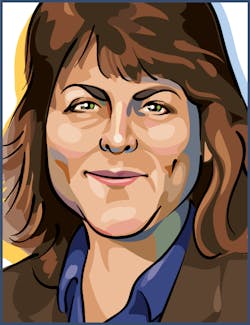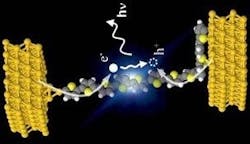
What can a single molecule do? Plenty—especially as it interacts with light. Today, the science of molecular photonics, loosely defined as the interaction of light with a molecule or molecules and perhaps best exemplified by the natural process of photosynthesis and the Holy Grail that is a molecular computer, is an emerging discipline that is gaining prominence as evidenced by a growing number of institutions focused on the subject:
- The Van 't Hoff Institute for Molecular Sciences (HIM; http://hims.uva.nl/about-hims) at the University of Amsterdam says, "The Molecular Photonics group aims to advance the fundamental knowledge of the dynamics of excited states in molecules and nano-sized objects, and to contribute with its expertise to applications of the photosciences." Joint group leader professor Fred Brouwer adds, "In particular we ask ourselves whether we can use the interaction with light to design new molecules with pre-programmed properties. And of course we would like to understand how and why nature uses very specific light-active molecules."
- The Molecular Photonics Laboratory (MPL; http://research.ncl.ac.uk/mpl/) at Newcastle University is capable of performing standard and high-pressure fluorescence and absorption measurements, optical-cryostat spectroscopic measurements, nanosecond laser flash photolysis, cyclic voltammetry, spectro-electrochemistry, Stark-effect spectrophotometry, light scattering, thin-film spin coating, and steady-state photolysis measurements.
- From July 21-24, 2016, the 4th International Symposium on Molecular Photonics will be held at Saint-Petersburg State University in Russia (see http://terenin.spb.ru/index.php/en-gb/). Symposium topics include Optical spectroscopy and photochemical processes in molecular and supramolecular systems, photonics of model biological systems and biological molecules, photochromism of organic compounds, and applied molecular photonics.
- From July 24-28, 2016, MSMLG 2016 (see https://msmlg.wordpress.com/)—the 5th International Conference on Molecular Sensors and Molecular Logic Gates—will be held at the University of Bath.
Indeed, molecular photonics is on the cusp of seeing practical applications. Specifically, just one single molecule can perform a variety of interesting functions with—you guessed it—the ultimate in small-form-factor, low-power-consumption, low-cost operation. Imagine a molecular computer and all the different elements you would need to create one, and just take a look at what has already been demonstrated:
THE FIRST SINGLE-MOLECULE LED: In early 2014, Laser Focus World reported on the first single-molecule LED. The image below shows an artist impression of electroluminescence in a single polythiophene molecular wire suspended between the tip and the surface of a scanning tunneling microscope. (Image credit: Guillaume Schull--IPCMS, CNRS/Université de Strasbourg)MOLECULAR LOGIC ELEMENTS: Professor Engin Umut Akkaya at Bilkent University in Turkey and his collaborators are using molecular logic gates to kill cancer cells (see http://euaresearch.com/research/). In his research, a molecule uses "and" logic to check for the presence of certain markers after which light is added and oxygen is released, destroying the cancer cells.
A SINGLE-MOLECULE-BASED OPTICAL TRANSISTOR AND OTHER SINGLE-MOLECULE SWITCHES: Laser Focus World reported the single-molecule transistor breakthrough back in 2009. And single-molecule switches have since then been reported by multiple groups, including Peking University and the University of the Basque Country.So what is the timeframe for a molecular computer? Theoretical physicist Michio Kaku makes his prediction in the following YouTube video, whereby molecular computers (which include DNA computers) precede quantum computers once silicon has been exhausted.
Wouldn't it be great if computers became so small and organic that they could be biologically compatible with humans and be implanted in our skulls to interface directly with our brain? Imagine having access to everything on the Internet with just a simple thought. It may sound impossible to some, but who could have imagined even 20 years ago that you could hold the power of the Internet in your hand thanks to the smartphone. I'm thinking that a hands-free computing future is closer than we think.

Gail Overton | Senior Editor (2004-2020)
Gail has more than 30 years of engineering, marketing, product management, and editorial experience in the photonics and optical communications industry. Before joining the staff at Laser Focus World in 2004, she held many product management and product marketing roles in the fiber-optics industry, most notably at Hughes (El Segundo, CA), GTE Labs (Waltham, MA), Corning (Corning, NY), Photon Kinetics (Beaverton, OR), and Newport Corporation (Irvine, CA). During her marketing career, Gail published articles in WDM Solutions and Sensors magazine and traveled internationally to conduct product and sales training. Gail received her BS degree in physics, with an emphasis in optics, from San Diego State University in San Diego, CA in May 1986.
